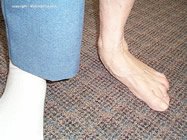What's new in the treatment of posterior tibial tendon dysfunction? This article discusses new and different ways to assess and treat PTTD.
New treatment recommendations for treatment of PTTD
I read an interesting article in Lower Extremity Review (LER) entitled Researcher Inch Towards Understanding of PTTD by Cary Groner. As a clinician and surgeon, you sometimes get set in your ways. When you read about a new approach to an old problem, it's great to get the wheels turning in your head, thinking about new ways to solve old problems. What I thought was interesting about this article were two new concepts that were introduced in the article; PTTD as the dysfunction of the system, not just the tendon. And the second concept, the foot core system.
 Traditionally we've looked at PTTD as a problem specific to the posterior tibial tendon. One of the specialists interviewed in the article was Patrick McKeon, PhD, ATC who suggested maybe we need to focus less on the PT tendon and look more at the sum total of contributing factors that may precipitate the onset of PTTD. McKeon recommends mechanical support of the tendon but advocates rehabilitation to strengthen the foot, to wean the foot off of orthotics. This global kind of approach to PTTD is a new way of thinking about an old problem. Wean folks off of their orthotics? That's a beautiful goal and should have been our primary treatment objective all along.
Traditionally we've looked at PTTD as a problem specific to the posterior tibial tendon. One of the specialists interviewed in the article was Patrick McKeon, PhD, ATC who suggested maybe we need to focus less on the PT tendon and look more at the sum total of contributing factors that may precipitate the onset of PTTD. McKeon recommends mechanical support of the tendon but advocates rehabilitation to strengthen the foot, to wean the foot off of orthotics. This global kind of approach to PTTD is a new way of thinking about an old problem. Wean folks off of their orthotics? That's a beautiful goal and should have been our primary treatment objective all along.
Bahram Jam, a physical therapist at York University in Toronto was also interviewed in the article. Jam's idea is to focus on the core or support from the intrinsic musculature in the foot. We're all familiar with core training for chronic lumbar pain (pilates). Why not think in those same terms when we begin rehab for PTTD?
The ideas put forth by Mckeon and Jam are interesting and worth an honest effort. It'll be interesting how these ideas play out in the literature over time. For these concepts to become an intrinsic part of our treatment of PTTD, it's going to require open-minded clinicians and motivated patients. It'll be interesting to watch these ideas become a reality in the medical literature.
Jeff
Medical Advisor
Myfootshop.com
Updated 4/23/2021
















